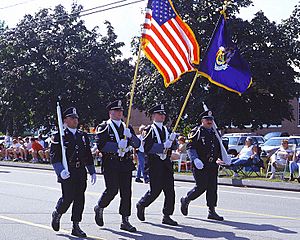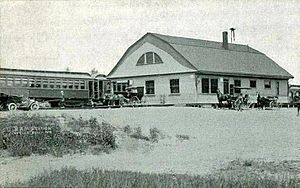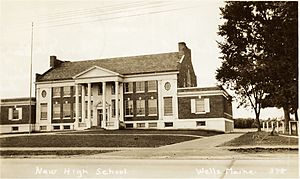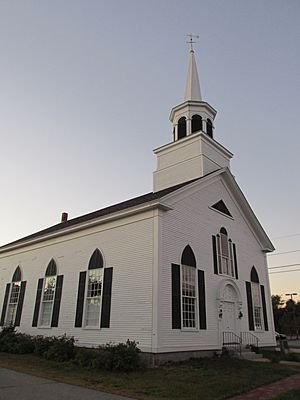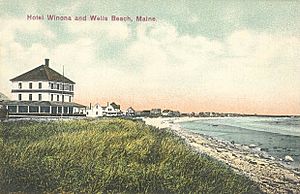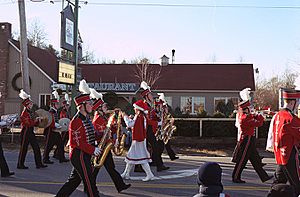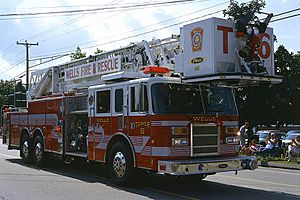Wells, Maine facts for kids
Quick facts for kids
Wells
|
|||
|---|---|---|---|
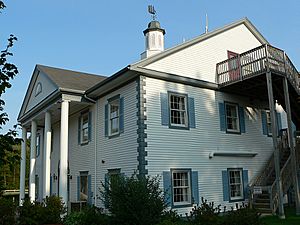
Town Hall
|
|||
|
|||
| Motto(s):
The Friendliest Town In Maine
|
|||
| Country | United States | ||
| State | Maine | ||
| County | York | ||
| Founded | 1643 | ||
| Incorporated | 1653 | ||
| Government | |||
| • Type | Town Meeting, Board of Selectmen, Town Manager | ||
| Area | |||
| • Total | 73.61 sq mi (190.6 km2) | ||
| • Land | 57.55 sq mi (149.1 km2) | ||
| • Water | 16.06 sq mi (41.6 km2) | ||
| Elevation | 177 ft (54 m) | ||
| Population
(2020)
|
|||
| • Total | 11,314 | ||
| • Density | 153.702/sq mi (59.345/km2) | ||
| Time zone | UTC−5 (Eastern (EST)) | ||
| • Summer (DST) | UTC−4 (EDT) | ||
| ZIP Codes |
04054 (Moody), 04090 (Wells)
|
||
| Area code(s) | 207 | ||
| FIPS code | 23-81475 | ||
| GNIS feature ID | 0582799 | ||
| Website | www.wellstown.org | ||
Wells is a fun resort town located in York County, Maine, United States. It was founded in 1643, making it the third-oldest town in Maine. In 2020, about 11,314 people lived there. Wells Beach is a very popular spot for summer vacations.
Contents
History of Wells
The Abenaki Native Americans called this area Webhannet. This name means "at the clear stream," referring to the Webhannet River.
Edmund Littlefield, who came from England, built the first mills here. He built a gristmill (for grinding grain) and later a woolen mill on the Webhannet River. He is known as "The Father of Wells," and there's a monument to honor him.
In 1622, the Plymouth Company in England gave land to Sir Ferdinando Gorges, who was the Lord Proprietor of Maine. This land included what would become Wells. In 1641, his cousin, Thomas Gorges, allowed Rev. John Wheelwright and other settlers from Exeter, New Hampshire, to live on the land. This area stretched from the Ogunquit River to the Kennebunk River.
After Ferdinando Gorges passed away in 1647, the Massachusetts Bay Colony claimed Maine. On July 5, 1653, Wells officially became a town. It was the third town in Maine to do so. The town was named after Wells, England, a small city with a cathedral.
Wells was an important frontier settlement for the English colonists. Other attempts to settle further north in Maine often failed because of conflicts with Native Americans. These groups were unhappy about people moving onto their land. Wells faced three major attacks, with the Raid on Wells in 1692 being the most famous. After the Battle of Louisburg in 1745, the area became safer.
Many early settlers from Wells joined the Continental Army during the American Revolutionary War. Some became heroes, like Captains Samuel Gooch, Nathanial Littlefield, and Jeremiah Storer. At Ocean View Cemetery, there's a Civil War monument honoring those who served. You can also visit Founder's Park, which has a walking trail, picnic area, and a replica of the first settlement home. Monuments there list the names of Wells' founding families.
Wells started as a farming community, growing hay and vegetables. Other important jobs included shipbuilding and fishing. In the 1800s, when the railroad arrived, Wells' sandy beaches became popular with tourists. Many inns and hotels were built along the coast. Today, tourism is still a big part of the town's economy.
In 2003, Wells celebrated its 350th anniversary. The year-long party included fireworks, a parade, a visit from a Russian circus, concerts, and historical reenactments. A special town flag was designed for the celebration. It shows the town's history, farming, the 2003 Town Hall, and tourism (represented by a train). The flag also has the motto: "Proud of our Past, Ready for our Future."
Geography of Wells
Wells is located on the southern coast of Maine. It is next to Kennebunk to the northeast and Ogunquit to the south. Other nearby towns include Sanford and North Berwick.
The town covers about 73.61 square miles (190.65 square kilometers). Most of this is land (57.55 sq mi or 149.05 sq km), and some is water (16.06 sq mi or 41.60 sq km). The Webhannet River flows through Wells. The highest point in town is a hill about 360 feet (110 meters) above sea level. The lowest point is sea level, along the Atlantic Ocean coast.
Transportation in Wells
Wells has several ways to travel to and from other communities:
- Interstate 95 (you can get off at Exit 19 of the Maine Turnpike)
- U.S. Route 1
- Maine State Route 9
- Maine State Route 9A
- Maine State Route 109
- The Pan Am Railways train line (which used to be the Boston & Maine Railroad)
- The Eastern Trail, a path for walking and biking, which is part of the East Coast Greenway
You can also catch an Amtrak train at the Wells Regional Transportation Center. The Downeaster train stops here several times a day. The center has a place to park your car and is close to the I-95 highway exit.
Education in Wells
Wells has four schools:
- Wells Elementary School (for kindergarten through fourth grade)
- Wells Junior High School (for fifth through eighth grade)
- Wells High School (for ninth through twelfth grade, and also has programs for adults)
- York County Community College
Wells is part of the Wells-Ogunquit Community School District.
Places of Worship
Here are some of the churches in Wells:
- Baptist
- Highpine Baptist Church
- Wells Branch Baptist Church
- Christian, interdenominational
- Shores Church
- Messiah Christian Church
- Church of the Nazarene
- Lighthouse Church of the Nazarene
- Pentecostal
- Mount Zion Chapel
- Roman Catholic
- Saint Mary's Church
- Old Catholic
- St. Francis of Assisi
- United Church of Christ
- Congregational Church of Wells
Fun Things to Do in Wells
Wells has many exciting places to visit:
- Seven miles of beaches: Drakes Island Beach, East Shore Beach, Wells Beach, and Moody Beach.
- The "Antiques Mile": This is a long stretch of road with many shops selling antiques.
- Division 9 Schoolhouse Museum: Learn about old school days.
- Historical Society of Wells & Ogunquit: Visit the Meetinghouse Museum & Library, which used to be the First Congregational Church.
- Maine Diner: A famous local restaurant.
- Rachel Carson National Wildlife Refuge: A great place to see nature and wildlife.
- Wells Farmers' Market: Buy fresh local produce.
- Wells Harbor Community Park: A nice park by the water.
- Wells Harbor Summer Concert Series: Enjoy outdoor concerts in the summer.
- Wells National Estuarine Research Reserve and Historic Laudholm Farm: Explore nature and learn about the coast.
- Wells Public Library: Find books and more.
- Wonder Mountain Fun Park: A fun amusement park.
Notable People from Wells
Many interesting people have come from Wells, including:
- George Burroughs, a clergyman.
- Kathleen Chase, a state representative for Maine.
- Ronald F. Collins, a state senator for Maine.
- Jonathan Courtney, a state senator for Maine.
- Nate Dingle, an NFL football player.
- Daniel W. Gooch, a US congressman.
- Ivory Kimball, a judge.
- Steve Lavigne, a comic book artist.
- Nathaniel Littlefield, a US congressman and a captain in the Revolutionary War.
- Ryan Peters (known as Spose), a rapper.
- John Fairfield Scamman, a US congressman.
- John Storer, who founded Storer College.
- Luis Tiant, a baseball player for the Boston Red Sox.
- Guy Tripp, a business executive and US Army brigadier general.
- Esther Wheelwright, who became Mother Superior of a religious order in Quebec City.
- John Wheelwright, a clergyman and one of the first settlers of Wells.
Population Information
| Historical population | |||
|---|---|---|---|
| Census | Pop. | %± | |
| 1790 | 3,070 | — | |
| 1800 | 3,692 | 20.3% | |
| 1810 | 4,489 | 21.6% | |
| 1820 | 2,660 | −40.7% | |
| 1830 | 2,978 | 12.0% | |
| 1840 | 2,978 | 0.0% | |
| 1850 | 2,945 | −1.1% | |
| 1860 | 2,878 | −2.3% | |
| 1870 | 2,773 | −3.6% | |
| 1880 | 2,450 | −11.6% | |
| 1890 | 2,029 | −17.2% | |
| 1900 | 2,007 | −1.1% | |
| 1910 | 1,908 | −4.9% | |
| 1920 | 1,943 | 1.8% | |
| 1930 | 2,047 | 5.4% | |
| 1940 | 2,144 | 4.7% | |
| 1950 | 2,321 | 8.3% | |
| 1960 | 3,528 | 52.0% | |
| 1970 | 4,448 | 26.1% | |
| 1980 | 8,211 | 84.6% | |
| 1990 | 7,778 | −5.3% | |
| 2000 | 9,400 | 20.9% | |
| 2010 | 9,589 | 2.0% | |
| 2020 | 11,314 | 18.0% | |
In 2010, there were 9,589 people living in Wells. There were 4,120 households, and 2,734 families. The town had about 166.6 people per square mile. The average household had 2.30 people, and the average family had 2.77 people.
The average age of people in Wells was 48.5 years old. About 18.6% of residents were under 18, and 21% were 65 or older. There were slightly more females (51.7%) than males (48.3%).
Images for kids
-
One of Wells' many one-room schools, now a museum.
See also
 In Spanish: Wells (Maine) para niños
In Spanish: Wells (Maine) para niños





